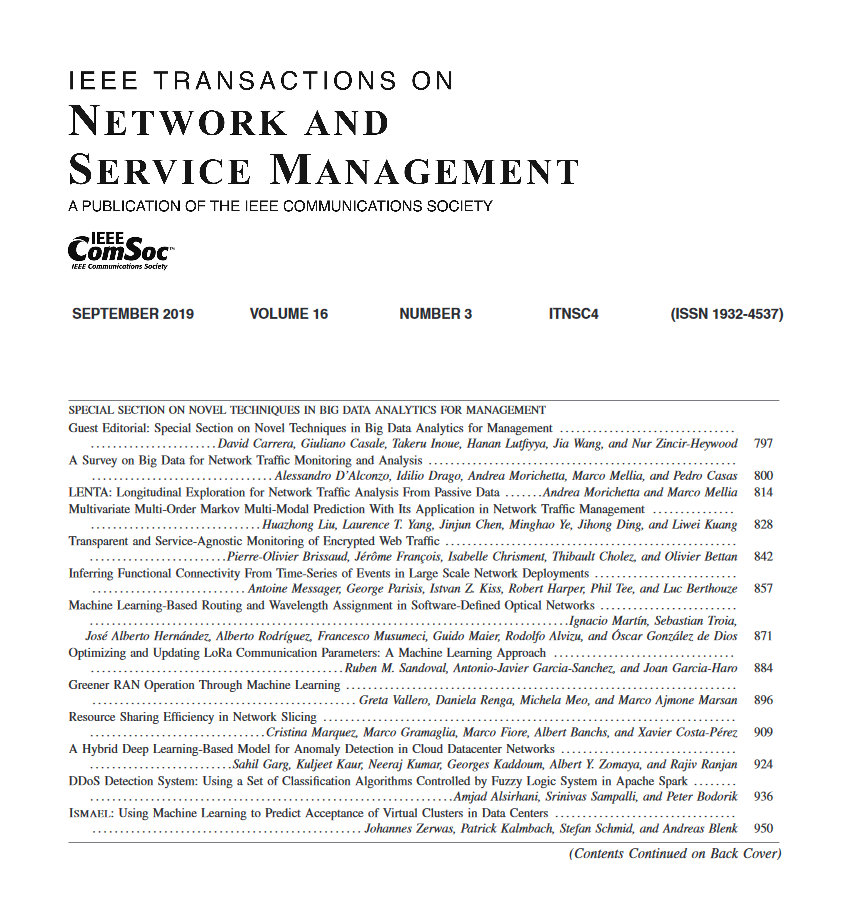Novel Bandwidth-Aware Network Coding for Fast Cloud-of-Clouds Disaster Backup
IF 5.4
2区 计算机科学
Q1 COMPUTER SCIENCE, INFORMATION SYSTEMS
IEEE Transactions on Network and Service Management
Pub Date : 2025-01-01
DOI:10.1109/TNSM.2024.3524787
引用次数: 0
Abstract
Cloud-of-clouds storage can enhance the data security and reliability of online applications by encrypting, encoding, and distributing user data across multiple clouds. Fast transferring large volumes of data through networks with limited bandwidths remains a practical challenge, especially in the event of disaster backup. To address this, we model a data storage process using an information flow graph and estimate inter-cloud traffic. We propose a new Network Coding-based Cloud-of-Clouds Backup (NC3B) framework, which enables collaborative encoding and data exchange among backup clouds to utilize inter-cloud bandwidth efficiently. We analytically corroborate that NC3B effectively reduces write operation latency. We also demonstrate the NC3B framework by incorporating two cutting-edge Reed-Solomon (RS) based data storage techniques, namely All-Or-Nothing Transform-RS (AONT-RS) and Converge AONT-RS (CAONT-RS), referred to as Network coding-based Backup AONT-RS (NBAONT-RS) and Network coding-based Backup CAONT-RS (NBCAONT-RS), respectively. To validate our approach, we deploy a real-world prototype storage system on Amazon EC2 using a cluster trace set, and underscore the effectiveness of NC3B, showcasing reductions in latency of up to 50% compared to state-of-the-art approaches, alongside throughput improvements of up to 98%. These findings underscore the benefits of NC3B in real-world storage scenarios.面向云中云快速灾难备份的新型带宽感知网络编码
云的云存储通过对用户数据进行加密、编码和跨多个云分布,可以增强在线应用程序的数据安全性和可靠性。通过带宽有限的网络快速传输大量数据仍然是一个实际挑战,特别是在发生灾难备份的情况下。为了解决这个问题,我们使用信息流图对数据存储过程进行建模,并估计云间流量。我们提出了一种新的基于网络编码的云的云备份(NC3B)框架,实现了备份云之间的协同编码和数据交换,从而有效地利用云间带宽。我们分析证实NC3B有效地降低了写操作延迟。我们还通过结合两种先进的基于里德-所罗门(RS)的数据存储技术来展示NC3B框架,即全或无转换-RS (AONT-RS)和融合AONT-RS (CAONT-RS),分别称为基于网络编码的备份AONT-RS (NBAONT-RS)和基于网络编码的备份CAONT-RS (NBCAONT-RS)。为了验证我们的方法,我们使用集群跟踪集在Amazon EC2上部署了一个真实的原型存储系统,并强调了NC3B的有效性,与最先进的方法相比,NC3B的延迟减少了50%,吞吐量提高了98%。这些发现强调了NC3B在实际存储场景中的优势。
本文章由计算机程序翻译,如有差异,请以英文原文为准。
求助全文
约1分钟内获得全文
求助全文
来源期刊

IEEE Transactions on Network and Service Management
Computer Science-Computer Networks and Communications
CiteScore
9.30
自引率
15.10%
发文量
325
期刊介绍:
IEEE Transactions on Network and Service Management will publish (online only) peerreviewed archival quality papers that advance the state-of-the-art and practical applications of network and service management. Theoretical research contributions (presenting new concepts and techniques) and applied contributions (reporting on experiences and experiments with actual systems) will be encouraged. These transactions will focus on the key technical issues related to: Management Models, Architectures and Frameworks; Service Provisioning, Reliability and Quality Assurance; Management Functions; Enabling Technologies; Information and Communication Models; Policies; Applications and Case Studies; Emerging Technologies and Standards.
 求助内容:
求助内容: 应助结果提醒方式:
应助结果提醒方式:


